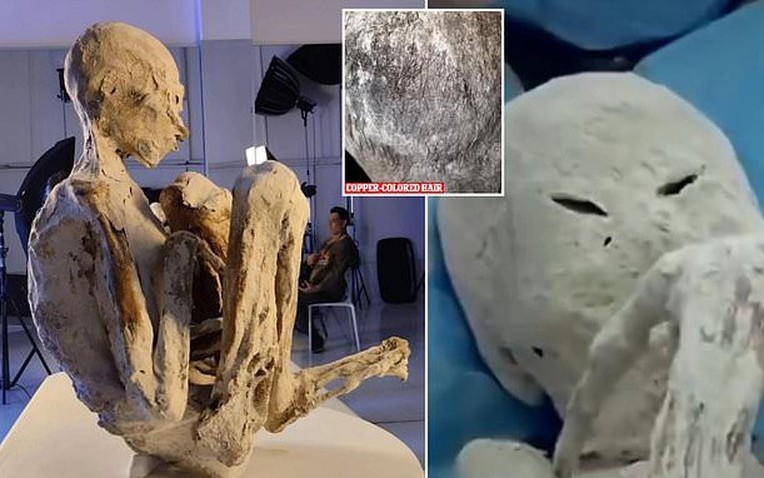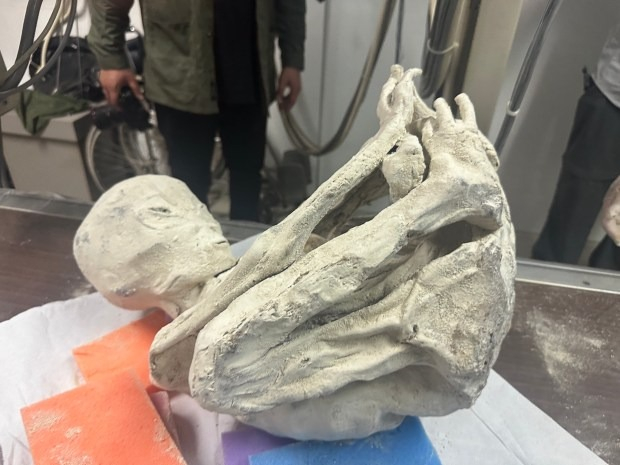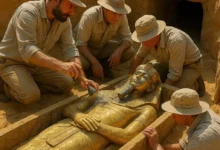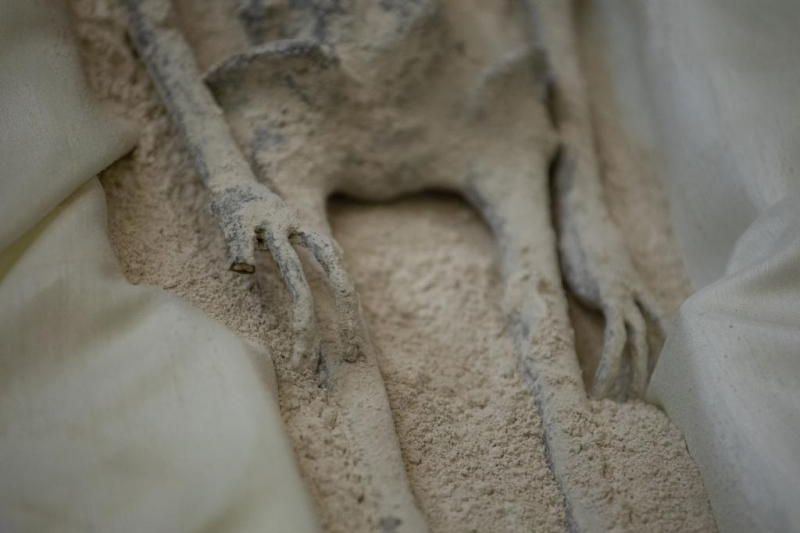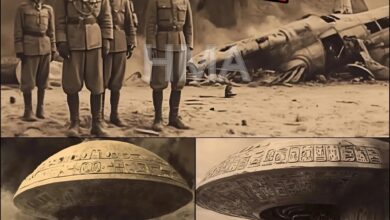“Latest news on alien presence “Controversy over “alien mummy” in Peru
The mystery surrounding the “alien mummies” in Peru is attracting increasing attention from the public and scientists, especially after new fingerprint analysis results showed that the controversial remains may not be human.
Decoding the Dulce “alien base”
Project Blue Book: The truth about aliens
Strange diagonal grooves on fingertips and toes
Journalist and alien researcher Jaime Maussan from Mexico – who last year became the subject of discussion when he had to explain to the Mexican Congress about aliens, has recently caused controversy again when he announced two 1,000-year-old “non-human” corpses in Peru. Along with this statement, Jaime Maussan also sought the help of American and European scientists to confirm the authenticity of the two mummies.
In an interview with the Daily Mail, Jaime Maussan said that “further analysis is underway” and that he is suing the Peruvian government to gain the right to transfer the bodies to more advanced laboratories in the United States. At the same time, Jaime Maussan continued to emphasize the idea that has been controversial for nearly a decade that the mummies could be “hybrids” between aliens and humans because the collected samples contained “30% undeciphered DNA”. According to Jaime Maussan, the lawsuit he is pursuing for the amount of 300 million USD is expected to take about 8 months. During this time, he and his colleagues, who are scientists in the United States, Mexico and Europe, will continue the experiments.
At the same time, Daily Mail science reporter Matthew Phelan published some controversial findings. These were strange diagonal grooves found on the fingertips and toes of a mummy known as María. Lawyer and researcher Joshua McDowell, who is backing up Matthew Phelan’s claims, examined María with the help of three independent forensic examiners from the US and said: “These are not traditional human fingerprint patterns. We don’t see any loops or whorls in the finger or toe prints.” In fact, fingerprint analysis, or “friction” fingerprints on the skin, has been a forensic tool since 300 BC in China and was codified in the US in 1902. However, María’s fingerprints did not match any known human fingerprint patterns. Researcher Joshua McDowell, with extensive experience in fingerprint analysis, also confirmed the uniqueness of these fingerprint patterns.
According to records, María was one of more than half a dozen “alien” mummies presented by Jaime Maussan. This mummy was found covered in diatomaceous earth – a fossilized powder left over from plankton. Joshua McDowell noted that, “the majority of the body of this mummy is covered in diatomaceous earth. However, on the fingers, there are exposed cuticle ridges that appear to be mostly straight lines.”
While acknowledging the strangeness of the straight ridge patterns, Joshua McDowell and his team still emphasize the need to be cautious when drawing conclusions. “It may be related to the way her skin was preserved,” Joshua McDowell said.
Controversial Studies
Research and investigations into the strangeness of mummies in Peru are still ongoing. Reuters news agency published an article by author Marco Aquino earlier this year based on statements by archaeologist at the Institute of Legal Medicine and Forensic Sciences of Peru Flavio Estrada that the “alien mummies” in Peru are actually dolls made from human bones. Flavio Estrada described the pair of mummies with separate three-fingered hands as actually dolls made from animal bones on Earth, glued together with modern synthetic glue.
“Our culture in the past created Machu Picchu. Our culture in the past created the Nazca Lines, they didn’t need any help from aliens to do that. Those who promoted it had economic interests and some other interests,” said Flavio Estrada.
However, Joshua McDowell still firmly rejected this information because he thought it was not really convincing and if the “alien mummies” were fake, there would need to be deeper evidence. Therefore, Joshua McDowell brought a team of American experts to Peru, including a Denver police investigator, a forensic anthropologist from Maryland and his father, Dr. John McDowell, a forensic dentist who identified the victims of the September 11, 2001 terrorist attacks.
“The team’s work continues until they find a way to discover the true nature of the “alien mummies”. I have been to Mexico several times, spent many days in Peru. The mysterious origin and unusual characteristics of these relics continue to intrigue researchers and the public, leaving many unanswered questions,” said Joshua McDowell.
So far, Joshua McDowell’s team has conducted a number of tests, including scanning the chemical composition of the object using fluorescence, a method similar to the hardware on NASA’s Mars Perseverance rover. This non-invasive technique has become prominent in examining the composition of materials without destroying or altering the material in the process. But researchers have also frequently reported limitations of the technology. For example, a group of environmental scientists in Arizona reported last year that their portable X-ray fluorescence tests failed to accurately detect the metal chromium, due to high iron content that drowned out the chromium signal.
Similarly, non-invasive studies conducted on the bodies that Jaime Maussan presented to the Mexican Congress led the head of the Mexican Navy’s Institute of Health Sciences to declare them “a single skeleton that has not been assembled with other parts.” But Dr. John McDowell cautions that all these non-surgical scans can only give scientists a limited idea of what these unusual bodies are actually made of. “We have done the best external assessment we can,” the forensic expert said, stressing that any further analysis of the mummies must be conducted “in accordance with all international laws relating to archaeological finds.”
For nearly 30 years, the US and Peruvian governments have worked closely to reduce the illicit trafficking of Peru’s priceless cultural and historical artifacts, rescuing more than 2,000 looted and stolen items that have now been returned to Peru. A trip to Peru by a team led by Joshua McDowell in April resulted in police and Peruvian Ministry of Culture officials storming a press conference with the intention of confiscating one of the newly exhibited mummies, Montserrat. This incident prompted Dr. John McDowell to write an open letter to Peruvian officials, published in La Noticia Perú, in which he “respectfully requests that those in authority facilitate a comprehensive assessment of all these recovered objects.”
“Working together will certainly allow us to determine whether any of these entities are unique and valuable archaeological discoveries or elaborate hoaxes,” Dr. John McDowell wrote in the letter, adding that the key is “direct examination of contaminant-free specimens,” as contamination is a particularly high risk associated with carbon dating these mysterious mummies.
As a previous study at the University of Chicago showed, the process of using the radioactive decay of a carbon isotope, carbon-14, to estimate when a living organism died can be easily disrupted by carbon from other sources. Even a little extra carbon from contamination will significantly skew the results. For example, a specimen that is millions of years old and is contaminated by just a small amount of carbon could yield an invalid age of 40,000 years. And these issues can become even more difficult in the case of a fraudster.
Physicist Dr. Bente Philippsen, head of the National Laboratory for Dating at the Norwegian University of Science and Technology, once explained: “If someone were to make a fake alien mummy from ancient animal bones, the radiocarbon date would still say ‘ancient,’ meaning the time the animal died.” Worse still, Dr. Bente Philippsen notes, there are even more serious problems when using this technique on suspected alien objects.
“In practice, radiocarbon dating is only applicable to samples that once lived on Earth, because other planets may have different 14C [Carbon-14 isotope] production rates in their atmospheres. If we want to radiocarbon date the remains of extraterrestrial visitors, we will need a calibration curve from their home planet,” the physicist stressed.
